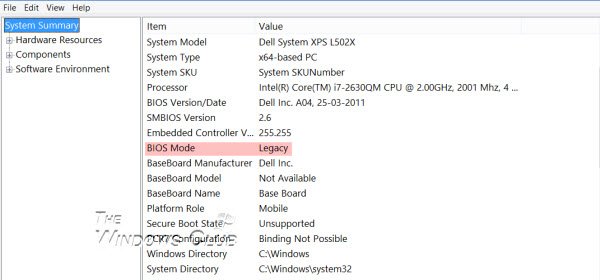Long-time Windows users might be well aware of the term – UEFI. For those who are not, UEFI is the abbreviated form of Unified Extensible Firmware Interface, a sort of BIOS replacement to set up the hardware and load and start an operating system. It was first introduced by Intel as Intel Boot Initiative which was later changed to EFI.
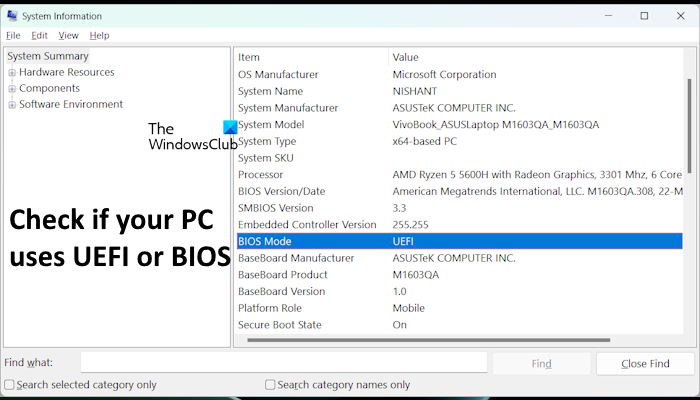
Later, EFI was then taken over by the Unified EFI Forum and was therefore named as UEFI. UEFI comes with a boot manager which removes the need for a separate boot loader. Besides, it gives you faster start-ups and better networking support.
Check if your PC uses UEFI or BIOS
Most recent Windows PCs are shipped with UEFI support, and it would be best to check with your OEM if your PC model number supports it. But if you want to check for yourself if your PC supports and uses UEFI/EFI or BIOS, follow the steps mentioned below.
- Use the setupact.log file
- Use the System Information tool
- Use the Command Prompt
- Use Windows PowerShell
Below, we have explained all these methods in detail.
1] Use the setupact.log file
The first method to check if your PC uses UEFI or Legacy is to open the setupact.log file. This file is located in the root directory of a Windows computer.
Open File Explorer and navigate to the following folder: C:\Windows\Panther.
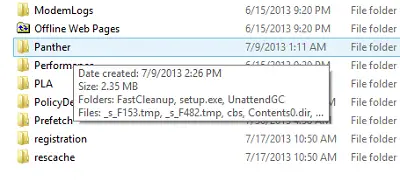
In the folder named Panther, you will see a text file titled setupact.log. Open this file by double-clicking on it. Despite being signed in as an administrator, you may not have permission to open this file. Hence, you have to take ownership of this file. Before you proceed, we suggest you create a system restore point. Don’t forget to revert the changes after viewing the content of this file.

Once you have opened setupact.log, click Ctrl+F to bring up the Find box and search for an entry named Detected Boot Environment.

Once you find Detected Boot Environment, you will notice the words BIOS or UEFI mentioned as follows:
Callback_BootEnvironmentDetect: Detected boot environment: BIOS
OR
Callback_BootEnvironmentDetect: Detected boot environment: UEFI

If your PC supports and uses UEFI, the word UEFI will appear, else BIOS.
Read: How to set and use BIOS or UEFI password.
2] Use the System Information tool
Alternatively, you can also open Run, type MSInfo32, and hit Enter to open System Information.
If your PC uses BIOS, it will display Legacy. If it is using UEFI, it will display UEFI! If your PC supports UEFI, then if you go through your BIOS settings, you will see the Secure Boot option.
In general, UEFI-enabled machines have faster startup and shutdown times as compared to BIOS-based machines. Here is a list of Windows features that require UEFI:
- Secure Boot protects Windows pre-boot process against bootkit and other malware attacks.
- Early Launch Anti-malware (ELAM) driver gets loaded by Secure Boot first and checks all non-Microsoft drivers before they are loaded.
- Windows Trusted Boot protects the kernel and system drivers during launch.
- Measured Boot will measure components from firmware till the boot-start drivers & stores these measurements in the TPM chip.
- Device Guard uses CPU virtualization and TPM support to support Device Guard with AppLocker, and Device Guard with Credential Guard.
- Credential Guard works with Device Guard and uses CPU virtualization and TPM support to protect security information like NTLM hashes, etc.
- BitLocker Network Unlock will automatically unlock Windows at reboot when connected to a corporate network.
- GUID Partition Table or GPT disk partitioning is required to enable large boot disks.
3] Use the Command Prompt
You can also use the Command Prompt to know if your system has Legacy BIOS or UEFI. First, open the Command Prompt as administrator, then type the following command and hit Enter. To open Command Prompt as an administrator, click on Windows Search, right-click on the Command Prompt, and select Run as administrator.
bcdedit
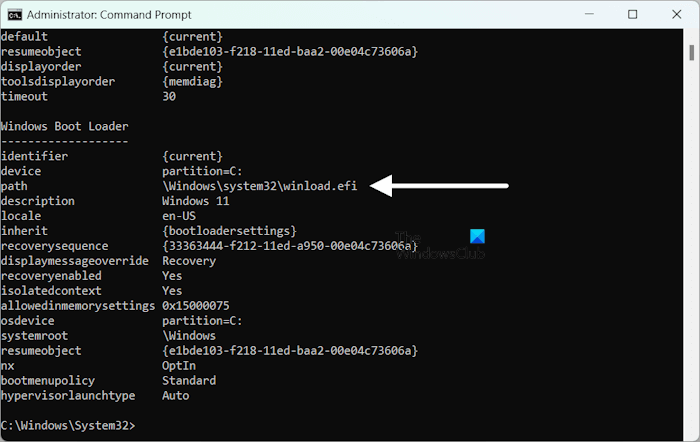
Now, look for the path under the Windows Boot Loader. If the path shows \Windows\system32\winload.efi, your system has UEFI.
If the path shows \Windows\system32\winload.exe, your system has Legacy BIOS.
4] Use Windows PowerShell
You can also use Windows PowerShell to know whether your system has Legacy BIOS or UEFI. Click on Windows Search and type PowerShell. Select PowerShell from the search results to open the PowerShell.
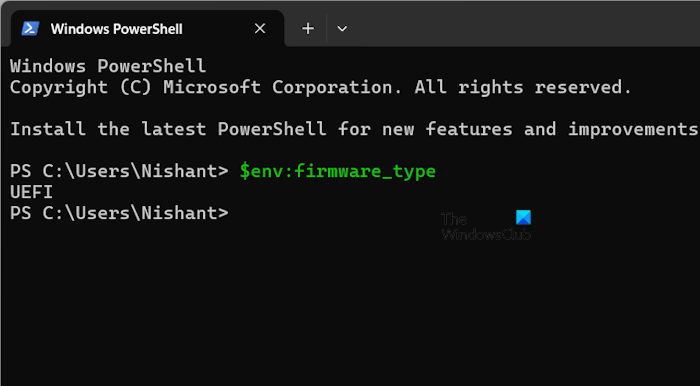
Copy the following command and paste it into the PowerShell window. After that, hit Enter.
$env:firmware_type
PowerShell will then show you your system BIOS mode.
I hope this helps.
Is BIOS replaced by UEFI?
Yes, BIOS has been replaced by UEFI. The BIOS mode in almost all modern computers is UEFI. UEFI has many advantages over Legacy BIOS, which is why it has replaced BIOS in modern computers. UEFI is more secure than Legacy. Moreover, Legacy BIOS supports the MBR partition table, while UEFI uses the GPT partition table. The greatest disadvantage of the MBR partition table is that it only supports up to 4 partitions.
Is UEFI better than BIOS?
Yes, UEFI is better than BIOS in many ways. There are many advantages of UEFI as compared to the Legacy BIOS mode. The Legacy BIOS supports the MBR partition table and UEFI supports the GPT partition table. Legacy BIOS supports only up to 4 hard disk partitions. The Legacy BIOS has a slow boot time as compared to the UEFI.
Read next: How to set and use BIOS or UEFI password on Windows.
